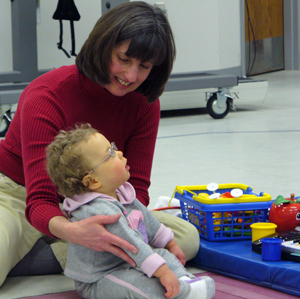 |
Physical therapist at MMI Reggie Harbourne recently received a $600,000 grant to study methods to improve postural control in infants with cerebral palsy. She will be collaborating on the project with Nick Stergiou, Ph.D., a biomechanist at The University of Nebraska at Omaha. |
But for babies with cerebral palsy, achieving that accomplishment isn’t easy.
“It’s an issue because most things people do require an upright posture,” said Reggie Harbourne, assistant professor of physical therapy at UNMC’s Munroe-Meyer Institute. “If you can’t sit up, you can’t interact with the world.”
Harbourne recently received a grant to study interventions that could improve the quality of life for children with cerebral palsy by improving their ability to sit up.
In her previous research, she and lead investigator Nick Stergiou, Ph.D., a biomechanist at the University of Nebraska at Omaha, were able to identify ways to evaluate the development of sitting posture in typically developing infants and infants with cerebral palsy.
“That was really important because often infants with cerebral palsy progress very slowly, and it’s not always visible to the eye, so we needed to quantify it with measurements,” Harbourne said. “Dr. Stergiou had the mathematical tools to do so. He can convert squiggly lines into measures of postural control.”
Through their collaboration, Dr. Stergiou and Harbourne discovered that physical therapy successfully improved sitting posture in infants with cerebral palsy.
That foundation was the basis for their latest study that will test the efficacy of an additional innovative intervention for children with moderate to severe cerebral palsy.
|
|
Harbourne got the idea for her research from James Collins’ studies at Boston University, in which vibratory insoles are put in the shoes of stroke patients to help them balance when they walk.
“These techniques have been used in studies of the elderly and standing, but there is not much out there about sitting, and sitting comes before standing,” she said.
The study will consist of two groups of children ages two to six with moderate to severe cerebral palsy. One group will receive physical therapy treatments to improve sitting control, while the other group will receive those same physical therapy treatments on the vibratory seat to see which improves sitting posture more.
“We’re hypothesizing that those who use the vibratory seat in addition to the physical therapy treatment are going to make more progress in their posture than those who just receive physical therapy,” Harbourne said, adding that she believes the improvements in posture control will coincide with improvements in functional arm use and focused attention, as well as participation.
“It’s important because if you can’t sit up and participate, it’s hard to be part of the conversation,” Harbourne said.
Harbourne is still recruiting patients and families for her study. For more information, call 559-5067.